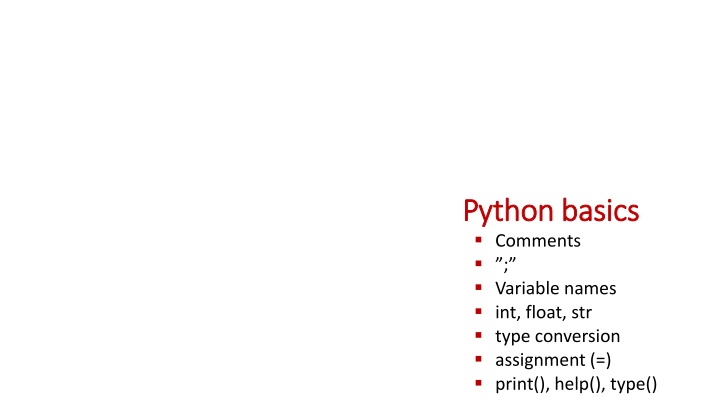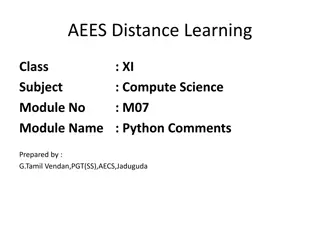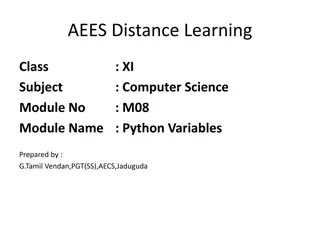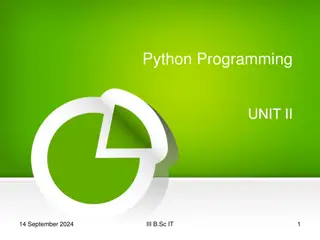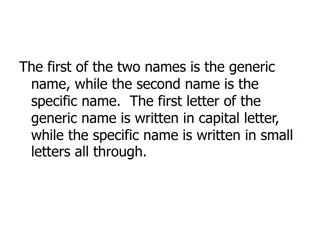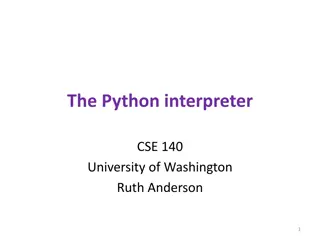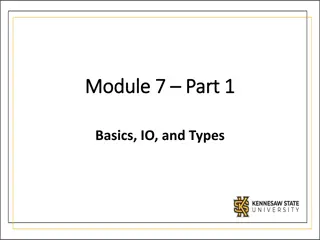Python Basics: Comments, Variable Names, Assignments, and More
Learn about the basics of Python programming, including the use of comments to explain code, defining variable names, type conversion, assignment operators, and general guidelines for coding practices. Explore how to effectively use comments to describe code functionality and understand the significance of variable naming conventions. Get insights into Python's syntax quirks such as the use of semicolons and the reserved keywords. Avoid common pitfalls like using reserved keywords as variable names. Dive into the world of Python with this comprehensive overview of fundamental concepts.
Download Presentation

Please find below an Image/Link to download the presentation.
The content on the website is provided AS IS for your information and personal use only. It may not be sold, licensed, or shared on other websites without obtaining consent from the author.If you encounter any issues during the download, it is possible that the publisher has removed the file from their server.
You are allowed to download the files provided on this website for personal or commercial use, subject to the condition that they are used lawfully. All files are the property of their respective owners.
The content on the website is provided AS IS for your information and personal use only. It may not be sold, licensed, or shared on other websites without obtaining consent from the author.
E N D
Presentation Transcript
Python Python basics Comments ; Variable names int, float, str type conversion assignment (=) print(), help(), type() basics
Python comments Python comments A # indicates the beginning of a comment. From # until of end of line is ignored by Python. x = 42 # and here goes the comment Comments useful to describe what a piece of code is supposed to do, what kind of input is expected, what is the output, side effects... Comments are aimed at people (including yourself) reading the code
The ; in Python The ; in Python Normally statements follow in consecutive lines with identical indentation x = 1 y = 1 but Python also allows multiple statements on one line, separated by ; x = 1; y = 1 neither pylint or flake8 like ; General Python PEP 8 guideline: avoid using ; Other languages like C, C++ and Java require ; to end/separate statements
Variable names Variable names Variable name = sequence of letters a - z , A - Z , digits 0 - 9 , and underscore _ v, volume, height_of_box, WidthOfBox, x0, _v12_34B, _ (snake_case) (CamelCase) a name cannot start with a digit names are case sensitive (AB, Ab, aB and ab are different variables) Variable names are references to objects in memory Use meaningful variables names Python 3 reserved keywords: and as assert break del finally class continue def elif else except for from global if import in is lambda nonlocal not or pass raise return try while with yield None False True
Question Question Not a valid Pyton variable Not a valid Pyton variable name name? ? a) print b) for c) _100 d) x e) _ f) python_for_ever g) Don t know Python reserved keyword Python shell > print = 7 > print(42) | Traceback (most recent call last): | File "<stdin>", line 1, in <module> | TypeError: 'int' object is not callable print is a valid variable name, with default value a builtin function to print output to a shell assigning a new value to print is very likely a bad idea (like many others sum, int, str, ...)
Integer Integer literals literals .... -4, -3, -2, -1, 0, 1, 2, 3, 4 .... Python integers can have an arbitrary number of digits (only limited by machine memory) Can be preceded by a plus (+) or minus (-) For readability underscores (_) can be added between digits, 2_147_483_647 (for more, see PEP 515 - Underscores in Numeric Literals)
Question Question What What statement statement will will not not fail fail? ? a) x = _42 b) _10 = -1_1 c) x = 1__0 d) x = +1_0_ e) Don t know
Python shell Float Float literals literals > 0.1 + 0.2 + 0.3 | 0.6000000000000001 > (0.1 + 0.2) + 0.3 | 0.6000000000000001 > 0.1 + (0.2 + 0.3) | 0.6 > type(0.1) | <class 'float'> > 1e200 * 1e300 | inf > 0.1+(0.2+0.3) == (0.1+0.2)+0.3 | False > x = 0.1 + 0.2 > y = 0.3 > x == y | False > print(f'{x:.30f}') # 30 decimals | 0.300000000000000044408920985006 > print(f'{y:.30f}') # 30 decimals | 0.299999999999999988897769753748 > import sys > sys.float_info.min | 2.2250738585072014e-308 > sys.float_info.max | 1.7976931348623157e+308 Decimal numbers are represented using float contain . or e Examples 3.1415 -.00134 124e3 = 124 103 -2.345e2 = -234.5 12.3e-4 = 0.00123 Floats are often only approximations, e.g. 0.1 is not 1/10 Extreme values (CPython) max = 1.7976931348623157e+308 min = 2.2250738585072014e-308 NB: Use module fractions for exact fractions/rational numbers.
Question Question What What addition addition order order is is best best ? ? 1e10 + 1e-10 + -5e-12 + -1e10 1e10 + -1e10 + 1e-10 + -5e-12 1e-10 + 1e10 + -1e10 + -5e-12 -5e-12 + -1e10 + 1e10 + 1e-10 Any order is equally good Don t know a) b) 1e10 = 10000000000 -1e10 = -10000000000 1e-10 = 0.0000000001 -5e-12 = -0.000000000005 c) d) e) f) Python shell > 1e10 + 1e-10 + -5e-12 + -1e10 | 0.0 > 1e10 + -1e10 + 1e-10 + -5e-12 | 9.500000000000001e-11 > 1e-10 + 1e10 + -1e10 + -5e-12 | -5e-12 > -5e-12 + -1e10 + 1e10 + 1e-10 | 1e-10 a) - d) give four different outputs
pi_approximation_riemann.py apx = 0.0 k = 0.0 while True: k = k + 1.0 apx = apx + 1.0 / (k * k) print(k, apx) Output Approximating Approximating = = 3.14159265359... 3.14159265359... ?2 6= + 1 1 12+1 22+1 ... 94906261.0 1.6449340578345741 94906262.0 1.6449340578345744 94906263.0 1.6449340578345746 94906264.0 1.6449340578345748 94906265.0 1.644934057834575 94906266.0 1.644934057834575 94906267.0 1.644934057834575 94906268.0 1.644934057834575 94906269.0 1.644934057834575 94906270.0 1.644934057834575 ... ?2= 32+ ?=1 = 1.6449340668... Riemann zeta function (2) This is not a course in numeric computations but now you are warned....
Python float IEEE Python float IEEE- -754 double precision* 754 double precision* A binary number is a number in base 2 with digits/bits from {0,1} 101102= 1 24+ 0 23+ 1 22+ 1 21+ 0 20= 16 + 4 + 2 = 2210 sign s 1 bit exponent e 11 bits coefficient c 52 bits IEEE-754 64-bit double s = 0 c +1 0011101101011100111010101010101010101010101011101100 1001010101100.0100011110010101111001110101010111110101100110101 2-6 e 1023 bits Python shell Float value Case > 1e200 * 1e200 | inf > -1e200 * 1e200 | -inf > 1e-200 * 1e-200 | 0.0 > -1e-200 * 1e-200 | -0.0 > 1e200 * 1e200 * 0.0 | nan (-1)s (1 + c 2 52) 2e 1023 (-1)s c 2 1074 +0 and -0 + and - NaN ( not a number ) 0 < e < 2047 e = 0, c 0 e = 0, c = 0 e = 2047, c = 0 s = 0, e = 2047, c 0 (*most often, but there is no guarantee given in the Python language specification that floats are represented using IEEE-754)
(type str) ) String String literals literals (type string-test.py print("abc") print('de\'f') print("'ghi'") print("'jk\nl'\"") print("mn\ o") print("p\\q\tr") print("\N{SNOWMAN}") Output Sequence of characters enclosed by single (') or double (") quotes "a 'quoted' word" "Hello World" 'abc' 'a "quoted" word' '_"_\'_"_' Escape characters \n newline \t tab \\ backslash \' single quote \" double quote \N{unicode name} A backslash (\) at the end of line, will continue line/string on next line Use triple single or double quotes (''' or """) for enclosing strings spanning more lines (in particular for Python Dosctrings, see PEP 257) $ python string-test.py abc de'f 'ghi' 'jk l'" mno p\q r
Question Question What print("\\\"\\n\n'") What does does the the following following print ? print ? \\\"\\n\n' \"\nn' \"\n ' "nn' \" a) b) c) d) e) ' Don t know f)
long-string-literals.py Long Long string string literals literals s1 = 'abc' "def" # two string literals print(s1) s2 = '"' "'" '"' # avoid escaping quotes print(s2) s3 = 'this is a really, really, really, \ really, really, long string' print(s3) s4 = ('this is a really, really, ' 'really, really, really, ' 'long string') print(s4) very_very_long_variable_name = ( 'this is a really, really, ' # line 1 'really, really, really, ' # line 2 "long string" # line 3 ) print(very_very_long_variable_name) Long string literals often need to be split over multiple lines In Python two (or more) string literals following each other will be treated as a single string literal (they can use different quotes) Putting parenthesis around multiple literals allows line breaks Advantages: avoids the backslash at the end of line can use indentation to increase readability allows comments between literals Python shell | abcdef | "'" | this is a really, really, really, really, really, long string | this is a really, really, really, really, really, long string | this is a really, really, really, really, really, long string
Raw string literals Raw string literals By prefixing a string literal with an r, the string literal will be considered a raw string and backslashes become literal characters Useful in cases where you actually need backslashes in your strings, e.g. when working with Python s regular expression module re Python shell > print('\let\epsilon\varepsilon') # \v = vertical tab | \let\epsilon arepsilon > print('\\let\\epsilon\\varepsilon') # many backslashs | \let\epsilon\varepsilon > print(r'\let\epsilon\varepsilon') # more readable | \let\epsilon\varepsilon
print(...) print(...) Python shell > print() | > print(7) | 7 > print(2, 'Hello') | 2 Hello > print(3, 'a', 4) | 3 a 4 > print(3, 'a', 4, sep=':') | 3:a:4 > print(5); print(6) | 5 | 6 > print(5, end=', '); print(6) | 5, 6 print can print zero, one, or more values default behavior print a space between values print a line break after printing all values default behavior can be changed by keyword arguments sep and end
print(...) and print(...) and help help(...) (...) Python shell > help(print) | Help on built-in function print in module builtins: | | print(...) | print(value, ..., sep=' ', end='\n', file=sys.stdout, flush=False) | | Prints the values to a stream, or to sys.stdout by default. | Optional keyword arguments: | file: a file-like object (stream); defaults to the current sys.stdout. | sep: string inserted between values, default a space. | end: string appended after the last value, default a newline. | flush: whether to forcibly flush the stream.
Assignments Assignments variable = expression x = 42 Multiple assignments right hand side evaluated before assignment x, y, z = 2, 5, 7 Useful for swapping x, y = y, x Assigning multiple variables same value in left-to-right x = y = z = 7 Warning i = 1 i = v[i] = 3 # v[3] is assigned value 3 In languages like C and C++ instead v[1] is assigned 3
Python is dynamically typed, type(...) Python is dynamically typed, type(...) The current type of a value can be inspected using the type() function (that returns a type object) In Python the values contained in a variable over time can be of different type In languages like C, C++ and Java variables are declared with a given type, e.g. int x = 42; and the different values stored in this variable must remain of this type Python shell > x = 1 > type(x) | <class 'int'> > x = 'Hello' > type(x) | <class 'str'> > type(42) | <class 'int'> > type(type(42)) | <class 'type'> x new type
Type conversion Type conversion Python shell > float(42) | 42.0 > int(7.8) | 7 > x = 7 > print("x = " + x) | Traceback (most recent call last): | File "<stdin>", line 1, in <module> | TypeError: must be str, not int > print("x = " + str(x)) | x = 7 > print("x = " + str(float(x))) | x = 7.0 > int("7.3") | Traceback (most recent call last): | File "<stdin>", line 1, in <module> | ValueError: invalid literal for int() with base 10: '7.3' > int(float("7.3")) | 7 Convert a value to another type: new-type(value) Sometimes done automatically: 1.0+7=1.0+float(7)=8.0
Questions Questions str(float(int(float("7.5")))) ? ? a) 7 b) 7.0 c) 7.5 d) "7" e) "7.0" f) "7.5" g) Don t know
